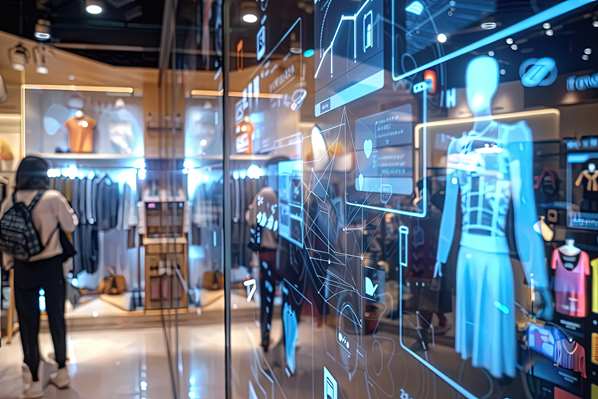
Retail is changing at breakneck speed. Over the past few years, technological advancements have driven seismic shifts in how businesses operate and connect with customers.
The global artificial intelligence (AI) in retail market size was valued at USD 7.14 billion in 2023 and is projected to grow from USD 9.36 billion in 2024 to USD 85.07 billion by 2032, reflecting the industry’s rapid embrace of digital transformation. Artificial intelligence (AI), in particular, has emerged as a powerful force, redefining customer service, streamlining operations, and creating new growth opportunities.
Recent studies suggest that by 2025, AI-driven technologies will influence up to 95% of customer interactions. Retailers implementing AI are seeing significant benefits, from enhanced efficiency and personalised shopping experiences to improved employee well-being. These advancements are making operations smarter and transforming the entire industry.
Cirrus’s latest whitepaper explores AI’s widespread impact on the retail industry, offering valuable insights into how this technology is shaping the future. Taken from the whitepaper, five key findings represent future trends revealing how AI will impact the retail sector.
1. Enhanced Customer Service Efficiency
AI is taking customer service to another level, by swiftly and accurately handling routine questions, allowing human employees to focus on more complex issues that require a personal touch. This shift reduces wait times and significantly boosts overall customer satisfaction.
How AI Improves Efficiency
AI technologies, such as chatbots and virtual assistants, are designed to handle various customer inquiries. These AI tools can process queries instantly, providing immediate responses without the need for human intervention. This is particularly beneficial for addressing common questions and tasks such as:
- Checking order status
- Providing product information
- Processing returns and exchanges
- Answering frequently asked questions (FAQs)
- Assisting with troubleshooting basic issues
2. Personalised Shopping Experiences
Today’s customers expect personalised service, and AI technologies are at the forefront of meeting these expectations. By analysing customer data and learning from interactions, AI tailors responses to create unique shopping experiences for each individual. This personalisation extends to product recommendations and marketing strategies, making the shopping journey more engaging and enjoyable. Retailers using AI for personalisation report higher customer engagement and increased sales.
How AI Tailors Shopping
AI leverages data from various sources, such as browsing history, purchase records, and social media activity, to understand individual customer preferences and behaviours. This data is then used to deliver personalised experiences in the following ways:
- Product Recommendations: AI algorithms analyse a customer’s past behaviour to suggest products they are likely to be interested in. This can include recommending items similar to those they’ve viewed or purchased, or suggesting complementary products.
- Customised Marketing: AI helps create targeted marketing campaigns that cater to individual preferences. This includes personalised emails, advertisements, and promotions that are more likely to resonate with the customer.
- Dynamic Content: Websites and apps can use AI to display content tailored to each user. This includes personalised homepage layouts, tailored search results, and customised navigation based on individual interests.
- Predictive Analytics: AI can predict future customer needs and behaviours, allowing retailers to offer products and services that meet those needs proactively.
3. Streamlined Operations
From predicting peak times and adjusting staffing levels to managing inventory, AI ensures operational efficiency. By forecasting demand, AI helps retailers stock popular products, reducing overstock and shortages. For example, AI can analyse historical sales data and external factors to predict which products will be in demand, helping retailers optimise their inventory management.
How AI Fine Tunes Operations
AI utilises data and advanced algorithms to improve various aspects of retail operations:
- Predicting Peak Times: AI can forecast busy periods by analysing historical sales data and external factors such as holidays, weather, and events. This allows retailers to adjust staffing levels accordingly, ensuring they have enough employees to handle increased customer traffic.
- Inventory Management: By predicting demand, AI helps retailers maintain optimal inventory levels. It identifies trends and patterns in sales data, enabling retailers to stock popular products while reducing excess inventory.
- Automated Reordering: AI systems can automatically reorder products when inventory levels fall below a certain threshold. This ensures that popular items are always in stock and reduces the risk of stockouts.
- Supply Chain Optimisation: AI can enhance the efficiency of the supply chain by predicting delays, optimising delivery routes, and managing supplier relationships. This leads to faster and more reliable restocking of products.
4. AI-Driven Analytics
AI-driven analytics enable retailers to predict customer needs and provide proactive support. This capability not only improves the customer experience but also increases loyalty and retention rates. Retailers can anticipate trends and adjust their strategies accordingly. By using AI to analyse large datasets, retailers gain insights into customer behaviour, preferences, and emerging market trends, allowing them to stay ahead of the competition.
How AI-Driven Insights Work
AI-driven analytics use the power of machine learning and big data to extract valuable insights from vast amounts of information. Here’s how they transform retail operations:
- Customer Behaviour Analysis: AI analyses browsing patterns, purchase history, and interaction data to understand customer preferences and behaviour. This helps retailers tailor their offerings to meet individual customer needs.
- Predictive Modelling: AI can forecast future trends and customer demands by examining past sales data and external factors. This allows retailers to plan inventory, marketing campaigns, and promotions more effectively.
- Sentiment Analysis: AI can analyse customer reviews, social media posts, and feedback to gauge customer sentiment. This helps retailers identify areas for improvement and address issues proactively.
- Market Trends Identification: AI identifies emerging market trends by analysing data from various sources, including competitors, market reports, and economic indicators. This enables retailers to stay ahead of the curve and capitalise on new opportunities.
5. Supporting Employee Mental Health
AI is playing a crucial role in improving staff well-being. Tools like Retail Trust’s AI-powered dashboard track well-being trends and offer recommendations to boost engagement, reduce absenteeism, and increase retention. AI can monitor stress levels and suggest breaks, creating a healthier work environment. Retailers can create a positive workplace culture by ensuring employees are well-supported, leading to higher productivity and job satisfaction.
How AI Improves Employee Experience
AI employs a variety of methods to maintain and improve the well-being of employees, ensuring a supportive and healthy work environment:
- Well-Being Tracking: AI-powered tools like dashboards collect and analyse data on employee well-being. This includes monitoring absenteeism, presenteeism, and overall engagement levels. By identifying trends and patterns, these tools can highlight potential issues before they become significant problems.
- Stress Monitoring: AI can assess stress levels in real-time by analysing factors such as workload, working hours, and even biometric data (like heart rate) if available. When high-stress levels are detected, AI systems can suggest timely breaks or workload adjustments.
- Personalised Recommendations: Based on the data collected, AI can provide personalised recommendations for improving mental health and well-being. This might include suggesting mindfulness exercises, recommending flexible work hours, or proposing wellness programs tailored to individual needs.
- Anonymous Feedback Channels: AI-driven platforms can offer employees anonymous ways to express their concerns and feedback. This encourages more honest communication and helps management address issues that may not surface through traditional channels.
- Resource Allocation: AI helps allocate resources more effectively by identifying the most beneficial well-being initiatives. For example, AI can recommend expanding these programs if certain wellness programs lead to better engagement and lower stress levels.
Final Thoughts
The future of retail jobs will focus more on human interaction and unique customer experiences as AI takes over routine tasks. Instead of replacing roles, AI will enhance them, allowing employees to engage in more meaningful and fulfilling work. Training and upskilling employees in digital literacy, problem-solving, and customer service are essential. Collaboration between businesses, governments, and educational institutions is critical to navigating these changes. Programs to enhance digital skills and foster innovation will help employees adapt to the evolving retail landscape. As AI becomes more advanced, ethical use will become a more prominent discussion, and any business looking to implement AI-driven tech must have clear goals and governance around its use.
About the Author
 Tatum Bisley is a seasoned product leader with an entrepreneurial disposition and extensive experience in driving product vision, strategy, and execution for technology companies, specialising in education, communications and SaaS products.
Tatum Bisley is a seasoned product leader with an entrepreneurial disposition and extensive experience in driving product vision, strategy, and execution for technology companies, specialising in education, communications and SaaS products.
I love anticipating value through new technologies, accelerating GTM growth, and leading in-house and offshore product teams by delighting customers, learners and users!
My top technologies for the future (and today):
- Augmented and Virtual Reality applications
- Remote work-enabling platforms
- Generative AI




